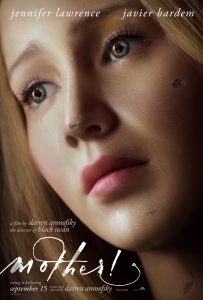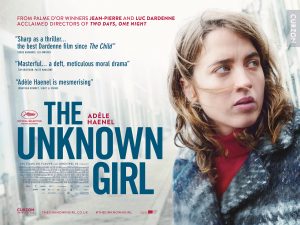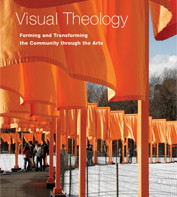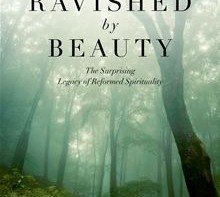In film critic circles—particularly film critics of a religious persuasion—the term ‘parable’ will be tossed out in a review to describe a film. A film may be a ‘parable of grace’ or a ‘parable for our times’. Recently, Darren Aronosky’s disturbing new film mother! has provoked the descriptor from a wider variety of critical reviews, both religious and secular.
In mother!, Jennifer Lawrence stars as Mother, a young woman married to an older poet (Javier Bardem). The two live in a large Victorian house in an isolated country utopia. He attempts to write and create while she maintains and repairs the house from damage it had sustained in a fire. When a Man (Ed Harris) and a Woman (Michelle Pfieffer) unexpectedly arrive at their door, Bardem’s husband character invites them in, to the chagrin of the hesitant Lawrence. Dark visions and distressing pangs grow within Mother as the guests become increasingly unorthodox and hostile, ultimately leading to violent confrontations.
In The Guardian, Mark Kermode called mother! an ‘eco-parable’, while the New York Times said it is ‘an ambitious parable hidden in a horror flick’. Reviews and discussions in The Ringer, Variety, LA Times and Collider all describe mother! as a parable. When audiences and critics were initially confused or outraged by mother!’s content, Aronofsky unpacked the film’s meaning in interviews throughout the publicity circuit. In his “Anatomy of a Scene” video from the New York Times, he describes how he wanted to make an allegory about Mother Nature and humanity’s relationship to the earth, using the stories of the Bible as his narrative inspiration. In an interview with Vulture, Aronofsky calls the film an allegory intended to excite people, to capture the emotion of our cultural moment, what he calls a ‘helpless rage’ in light of environmental disasters. It is an allegory, a metaphor, a parable.
Every time this happens, I think of the classic line from The Princess Bride about the word ‘inconceivable’: ‘You keep using that word. I do not think it means what you think it means’.

Are allegories and parables equivalent forms or genres, or are there significant distinctions to be made? Can modern-day films follow the forms and conventions of parables? What is a parable, exactly, and how does one properly apply the category to cinema?
The very definition of a parable is enigmatic and troubling. Merriam-Webster defines it simply as ‘a story that teaches a moral lesson’, an explanation so broad as to be non-definitive. Within the history of biblical scholarship, many turn to C.H. Dodd’s classic definition from his 1935 book, The Parables of the Kingdom: ‘At its simplest the parable is a metaphor or simile drawn from nature or common life, arresting the hearer by its vividness or strangeness, and leaving the mind in sufficient doubt about its precise application to tease it into active thought’ [1]. For Dodd, the simile/metaphor characteristics are vital to the parable—this is an image before it is a narrative story. Operating within the historical-critical tradition, Dodd sought to find the true meaning of the parables within their historical context, the kernel of Jesus’ original message within the Gospel writers’ interpretations.
Differing from Dodd and others in this original-historical-meaning framework, a number of other scholars (Jeremias, Snodgrass, et al.) offered a literary or reader-oriented approach to the parables, asking about the nature and meaning of their narratives within the Gospel narratives as texts. Robert Funk called parables ‘language events that ‘reshaped the world of the listener to the point where a judgment was necessary about the everyday world’ [2]. For Funk, the parable is perpetually unfinished; its significance comes through its being a metaphor, where the meaning is within its very metaphorical structure and images. Still, this metaphor is couched within a narrative structure—these are stories to be told and interpreted by the audience.
What remains consistent in these recent scholars’ divergent approaches is the subversive element of the parable. They have surprising or extraordinary characteristics within a seemingly ordinary setting.
Traditionally, the parables have often been understood as moral example stories or allegories intended to illustrate spiritual truths in a concrete narrative. The elements within each of these allegories or similes were coded forms for timeless truths (e.g. the ‘seed’ is the ‘word of God’, the ‘father’ to the prodigal is the loving Godhead, etc.).
It has been increasingly recognised in scholarship that the purpose of a parable is more disequilibrating and peculiar. Thus, I have found John Dominic Crossan’s spectrum of stories to be a helpful framework for understanding parable. In his little book The Dark Interval, Crossan contrasts myth with parable as opposing poles. A myth acts to establish the world, to offer clear definitions of reality and truth, to bring about reconciliation and comfort through structure and foundation. On the opposite end of the spectrum, parable serves to ‘show us the seams and edges of myth’ [3]. The parable unnerves, provokes, and raises questions. Crossan’s full spectrum of story looks like this:
Myth – Apologue – Action – Satire – Parable
Crossan offers simple definitions for each type: ‘Myth establishes world. Apologue defends world. Action investigates world. Satire attacks world. Parable subverts world’ [4]. A myth offers a comforting metanarrative, while the apologue serves as a persuading fictional depiction of that narrative. Action is a typical novel, introducing characters within a setting. Satire openly ridicules the establishment, painting in broad brush strokes to capture the attention of the satirised culture, institution, or individuals. Unlike satire, parables are much more covert in their agendas. Crossan notes that parables ‘can only subvert the world created in and by myth’. Parables push at the limits and boundaries of our norms and beliefs, compelling the audience to respond in some form. ‘Parable is always a somewhat unnerving experience. You can usually recognize a parable because your immediate reaction will be self-contradictory’ [5]. A parable is at-once inviting and uncomfortable, engaging and aloof.
Paul Ricoeur offers yet more clarity in defining the unique form of the parable. Combining and transcending historical-critical and literary methods, in Ricoeur’s understanding the parable is ‘the conjunction of a narrative form and a metaphorical process’, a unifying blend of story and symbol [6]. He notes the parable’s ‘essential profaneness’, how the story is constructed around normal, ordinary events and people [7]. God, religion, or cosmic events are almost never mentioned in Jesus’s parables (with the notable exception of Luke 16:19-31). The ‘religious’ or transcendent elements of the parable are precisely in their everyday settings with extravagant conclusions.
For Ricoeur, the power of parables is in their ordinariness: ‘The parables recount stories that could happen and even that have happened. But it is precisely this realism of situations, characters, and predicaments that sets off the eccentricity of the behavior that the kingdom of God is compared to. The extraordinary within the ordinary, such is the logic of meaning in the parables’ [8]. The parable begins with a simple, unassuming narrative then moves into a sudden or extravagant turn, one which takes the audience by surprise. The paradox of the parable is that ‘it begins in an ordinary manner, only to turn to the fantastic, but to a fantastic that remains a fantastic of the everyday, without the supernatural, as it appears in fairy tales or in myths….that is what baffles one and leads one to ask: Why is this story told?’ [9]
Returning our attention to mother!: Is this R-rated allegory of the Biblical narrative a true parable? Like a parable, it is provocative and unsettling, but its provocation stems from its use of extreme violence and didacticism to illustrate the nature of humanity’s treatment of the environment. Aronofsky’s interviews explaining the meaning of mother! subvert the film’s own subversion—by choosing to tell, not show, Aronofsky undoes what makes a parable unique in its form.
Parables, like a good joke, fall flat when one has to resort to explicit explanations to communicate their meaning.
The thing about allegories is that the characters are intentionally symbolic, serving as avatars for Big Ideas or as parallels to other characters in familiar narratives (such as the biblical story). The stories are not meant to stand on their own, while a parable can hold its own and contain a variety of valid interpretations. Aronofsky also never calls his own film a parable—he describes it primarily as an allegory. He takes the biblical narrative—from Adam and Eve all the way to Jesus—and utilizes it through his own character creations, expecting the audience to grasp the biblical allusions.
Per Ricoeur, mother!’s use of cosmic and overtly religious elements does not fit well within the form of the parable; per Crossan, an allegory’s overt symbolism is not parabolic either. Crossan places allegory as a subform of an apologue. Even if Aronofsky’s myth is opposed to the central myth of our cultural ethos, it is more mythic than parabolic in form and content. ‘Parables are not “better” than…allegories, they are simply different literary forms with different functions’ [10].
Based on Ricoeur and Crossan, Aronofsky’s weighty tale about environmentalism may be more akin to apologue, or even satire, in its heavy-handed allegorical message and didactic warnings. This is not to say mother! is a poor film, only that audiences should expect allegory instead of parable.

So where are present-day cinematic parables to be found? Though mother! may be more of an R-rated allegory, I would contend that another 2017 film is parabolic in its form and content: The Unknown Girl, from Belgian filmmakers Jean-Pierre and Luc Dardenne. The film follows Jenny (Adèle Haenel), a youthful, ambitious doctor who serves her working-class patients with rich empathy and a sense of purpose. When the door to Jenny’s medical clinic rings after closing hours, she does not answer in order to teach her intern a lesson on patient-doctor boundaries. It is later revealed that a young woman was found dead across the street from the clinic. Seen on surveillance footage, the unknown girl had attempted to get into the clinic building, seemingly to escape from an unseen assailant. If the door had been opened, what then? The scenario raises a plethora of ethical questions for both Jenny and the audience, particularly about what it means to love one’s neighbour as oneself.
Both films—mother! and The Unknown Girl—focus on female protagonists in their search to understand a mystery kept from them; both films utilize handheld camerawork and close-ups of faces to communicate emotion and suspense; both attempt to elicit an ethical response within the audience. Yet the Dardennes take a more parabolic approach to their craft. The Dardennes’ moral mystery is at once quite ordinary in terms of its genre conventions and urban setting yet extraordinary in its formal brilliance and ethical considerations.
The fantastic elements of The Unknown Girl are not in their allusions to myths or biblical texts but in the everyday decisions made by a doctor face-to-face with the responsibility of saving human lives. There is nothing particularly religious in the film, and certainly nothing as fantastical as Aronofsky’s final sequences (though a brief reference to a burial in a ‘potter’s field’ may suggest further inquiry into potential biblical inspirations). Yet there is a transcendence within the Dardennes’ social realism—following Ricoeur, the ‘religious’ experience of the Dardennes’ cinematic parable is seen in the surprising dénouement, the unexpected cathartic and affecting conclusion to Jenny’s search.
The Unknown Girl fits within the genre of a modern-day detective story yet subverts audience expectations as Jenny journeys further into the mystery of the girl’s origins. This subversion is not outrageous or overt, a la Aronofsky; where one typically expects violence or revenge, the Dardennes offer reconciliation and atonement for sins. Aronofsky’s mother! is shocking in its extreme depictions of human depravity; the Dardennes’ The Unknown Girl is surprising in its quiet moments of ordinary grace, even as it raises the question suggested by Ricoeur—Why is this story told?—and invites the audience to respond.
[1] C.H. Dodd, The Parables of the Kingdom (London: Nisbet & Co., 1935), 16.
[2] David B. Gowler, What Are They Saying About the Parables? (New York: Paulist Press, 2000), 19.
[3] John Dominic Crossan, The Dark Interval: Towards a Theology of Story (Sonoma, CA: Polebridge Press, 1988), 38.
[4] Crossan, 42.
[5] Crossan, 39.
[6] Paul Ricoeur, ‘Biblical Hermeneutics’, Semeia 4, (1975): 30.
[7] Paul Ricoeur, ‘Manifestation and Proclamation’ in Figuring the Sacred: Religion, Narrative, and Imagination, trans. David Pellauer, ed. Mark I. Wallace. (Minneapolis: Fortress Press, 1995), 57.
[8] Ricoeur, ‘Manifestation and Proclamation’, 60, emphasis mine.
[9] Paul Ricoeur, ‘The “Kingdom” in the Parables of Jesus’, Anglican Theological Review 63, no. 2 (April 1981): 167.
[10] Crossan, 99.






I love what you guys are usually up too. This sort of clever work and reporting! Keep up the excellent works guys I’ve added you guys to my personal blogroll
Regards
Ross Alisha
It’s a shame you don’t have a donate button! I’d most certainly donate to this excellent blog! I suppose for now i’ll settle for book-marking and adding your RSS feed to my Google account. I look forward to new updates and will talk about this blog with my Facebook group. Talk soon
We are thrilled that you are enjoying Transpositions! In lieu of being able to donate monetarily, we encourage you to support the arts, and especially theological engagement with the arts. We also invite you share Transpositions’ links, tweets and our Facebook page with friends!
I have been reading out many of your stories and i can state clever stuff. I will definitely bookmark your site.
We are a group of volunteers and opening a new scheme in our community. Your website offered us with valuable info to work on. You’ve done a formidable job and our entire community will be thankful to you.
Regards
Ross Alisha